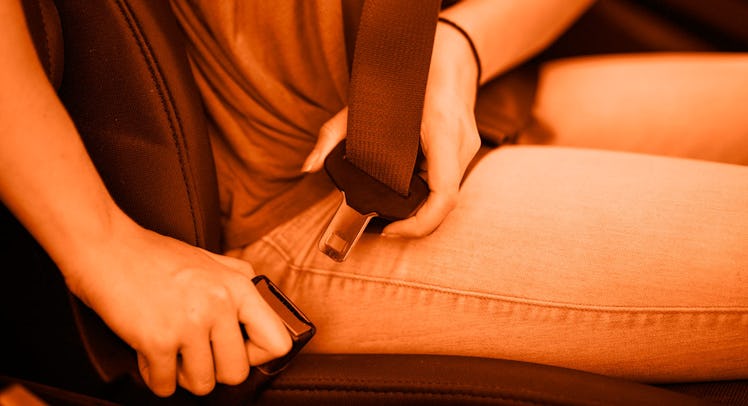Why Even The Strongest Arm Is No Replacement For A Seatbelt
That weird gesture you make when you stop short isn't helping anyone.

Your dad reflexes may insist otherwise, but the truth is that, no matter how much you work out, you’re useless in a car crash. That thing where you put your arm in front of your child or wife? It’s a nice gesture, but it’s just that: a gesture. Within the split second that your vehicle decelerates from 40 miles per hour to zero, as your body rushes to meet the seatbelt or the windshield, that arm won’t accomplish anything. But you reach out anyway. Why? Mostly to reassure yourself. Unfortunately, a close look at the numbers indicates how comical that sort of reassurance actually is.
Why won’t a strong dad arm work about as well as a seat belt, especially when you’re merely stopping short at a red light? Because physics. Unfortunately, love is the most powerful force in the universe, but it doesn’t stand a chance against momentum. On some level, we know this, but here are the actual details of how it all works.
The Physics Of A Car Crash
Let’s say you’re driving an average-sized car at about 40 miles per hour, when you suddenly hit a tree and come to a complete stop. The car itself will experience 240,000 lbs or 120 tons of force. We know this thanks to a handy equation: F= -½ mv^2 / d. That is, the average force an object experiences is can be calculated by multiplying that object’s mass and velocity, multiplying that by -½, squaring the solution, and then dividing by the stopping distance.
We can apply the same principles to figure out the sort of forces the passengers might experience in a crash. In our above example, an adult who weighs about 150 lbs would experience 4 tons of force; a child who weighs 50 lbs would face about 1.3 tons of force. Importantly, one of the best ways to mediate that force is to change the stopping distance. Since “d” is in the denominator of our equation, larger stopping distances mean smaller forces.
So… What Does a Seatbelt Do?
The above figures only apply if the adult and child travel the same distance as the car before stopping, which is what would happen if the passengers were glued to their seats or wearing non-stretching harnesses that kept them entirely in sync with the car from start to finish. That is almost never the case. Most seatbelts are the stretching variety, which add about 50 percent to the car’s stopping distance. That’s a good thing, because if the child in our crash went from 40 mph to zero in 1.5 feet rather than 1 foot, he’d experience 1,000 fewer pounds of force.
What Would Happen If I Didn’t Wear A Seatbelt?
Glad you asked. You would not be in sync with the car—at least, you wouldn’t end up that way. Because when the car is travelling 40 miles per hour, so are you. But while the car stops over the course of one foot as its hood caves in, you’re going to fly into the windshield or steering wheel at 40 miles per hour, arriving at a complete stop over the course of only a few inches. Studies suggest that seat belts increase stopping distance about 5-fold, so it’s not unreasonable to assume that, without a seatbelt, the hapless child in our scenario gets only about 0.2 feet to decelerate from 40 to 0 miles per hour—subjecting him to 6.6 tons or 14,000 lbs of force.
Bottom-Line: Why Your Arm Makes A Rotten Seatbelt For Your Kid
First of all, there’s no way you’re going to be able to get your arm in position fast enough for it to function as a reasonable seatbelt. You can mess with the above calculation to figure out exactly how much time you’d have but, suffice it to say that it’s less than one tenth of a second.
Dad reflexes are good, but they’re not that good.
More importantly, no arm workout can prepare you to absorb the sort of force that you would need to stop your child from flying into the windshield. Remember—the same forces your child experiences flying forward are the forces that any good seat belt needs to withstand. Seat belts are designed to handle a sudden jolt of 1,000 lbs of force. Your arm is not. Now, since your arm isn’t secured to anything, it would probably give under the force of your passenger and flop away. But if you were to theoretically secure your arm 1.5 feet away from your child, you’d break every bone in your arm the moment your child made impact. It takes only 900 lbs of force to break a femur. Your measly radius and ulna would snap like twigs.
So stick with a seat belt—your guns are admirable, but they’re no match for polyester and nylon.
This article was originally published on